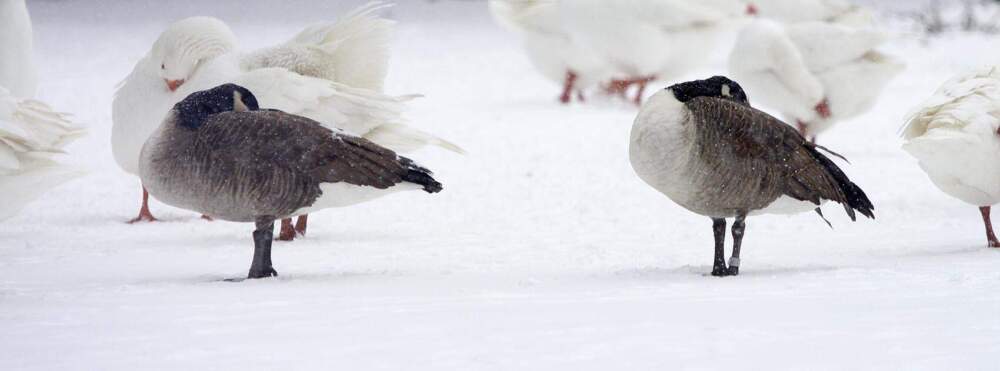Advertisement
How bird flu 'upended' a Weymouth wildlife hospital

The staff at the New England Wildlife Center in Weymouth had to adjust how they treat animals once bird flu hit Massachusetts.
"Bird flu has changed, upended the entire way we work," said Zak Mertz, CEO of the wildlife rehabilitation center, which treats thousands of animals annually. He said almost half its patients are birds.
The organization's day-to-day operations now require more resources to purchase protective gear — including masks and clothing to shield staff and avoid spreading the virus; space in the hospital to isolate birds for testing; and money to conduct testing, Mertz said.
The new procedures start the moment animals arrive at the facility. Birds aren't allowed into the center until staff members conduct a quick examination for physical symptoms typical of bird flu. These include lack of coordination, and coughing or sneezing, said wildlife veterinarian Priya Patel.
If the animal doesn't show obvious symptoms, staff don full protective gear, including hazmat suits, N-95 masks and gloves, to bring the bird inside for further testing. Staff then swab the bird's nose or mouth and send the samples to a lab at Tufts University to be tested for the virus.
Since December, the avian influenza virus has killed at least 1,000 wild birds in Massachusetts, according to state officials.
Estimating the full number of affected birds is tough, state wildlife experts said. The same group of dead birds may be reported multiple times, explained Nicole McSweeney, assistant director for outreach and education at the Massachusetts Division of Fisheries and Wildlife.
And most dead birds aren't tested. When they are, preliminary results can take days to receive. Confirmed results might take months, McSweeney said.
So far this month, there haven't been any reported domestic bird deaths due to bird flu said Phu Mai, a spokesperson for the Massachusetts Department of Agricultural Resources. A suspected outbreak in Plymouth last month killed 30 domestic birds, including swans and geese.
The virus driving the current outbreak, known as H5N1, has been detected in wild and domestic birds around the globe, including outbreaks at poultry farms, and has also affected dairy cattle.
Advertisement
Health officials say the risk to people remains low. The number of known human infections in the U.S. is limited, and most recent cases appear to be mild. Officials reported the country's first death of a person infected with bird flu last month.
This particular strain of bid flu was first detected in Massachusetts in 2022, according to state officials. Cases in birds tend to increase during the winter months because colder temperatures force the animals to flock in close proximity, Mertz said. And this season offered especially good conditions for the virus to spread.
"This was our first really cold winter in a couple of years," he said. "And so you had infected birds, and all of a sudden there was way less open water for them to find food and make shelter in. And so when the lakes and ponds froze, it crammed all of these birds into a very tight area."
In addition, eastern Massachusetts is a stop on the migration route for many species, providing opportunities for new variants of the virus to be introduced by birds passing though the state, Mertz said.

Because there is no cure for the virus, staff can only offer supportive care. Patel said cases they've seen this year are so severe that chances of recovery are "very, very small," and infected birds will likely die within two days.
But she's noticed birds may be building an immunity to older strains. When her team identifies birds with those variants, they tend to have mild symptoms and recover.
Tracking developments like this is just as important as crafting an immediate response to bird flu, Patel said. Her veterinary team works with the Tufts lab to detect variants, test for antibodies and monitor immunity.
The New England Wildlife Center also partners with the Massachusetts Division of Fisheries and Wildlife to conduct surveillance testing. They coordinate field teams to test birds at suspected outbreak sites, like in Plymouth.
Mertz sees wildlife rehabilitation as the front line against emerging disease outbreaks. Sixty percent of new infectious diseases originate in animals, according to the Centers for Disease Control and Prevention.
" It's not just about treating them and getting them healthy and getting out the door anymore. It's about doing all of that, and then also understanding what threats are coming down the pike," he said.
Patel said she’s seen fewer cases of bird flu in the past week, likely because of slowing bird migration, and she hopes the worst of the season has passed. But she said staff at the center is still on the defensive.
"We're just taking every day as it comes, noting new changes so that we can track how not only this virus is changing and what new species that might be affecting, but potentially other new diseases that might be coming through as well," she said. " It's an ever-changing situation."
